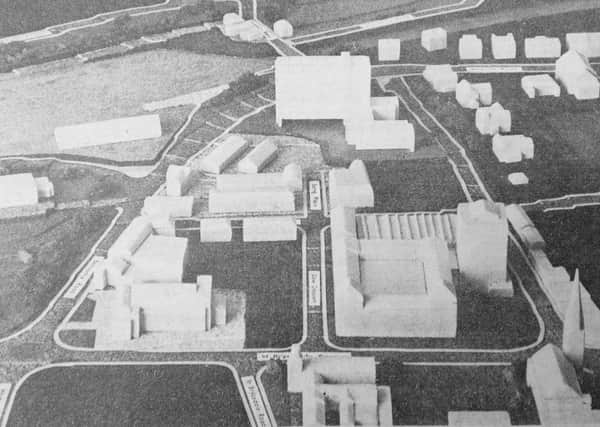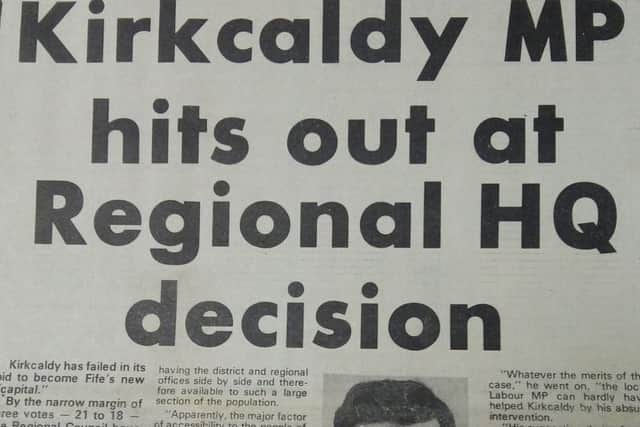How Kirkcaldy lost out as political capital of Fife in 1970s


How about Carlyle House in the heart of Kirkcaldy – in the very office block which is now home to the Fife Free Press?
Had decisions taken in 1974 been different, the Lang Toun, and not Glenrothes, would have been the political capital of the Kingdom. Not for the first time, we lost out.
Advertisement
Hide AdAdvertisement
Hide AdThe story began with a planning application to build a nine-storey office block on the site that used to be Barry Ostlere and Shepherd’s linoleum factory in Carlyle Road.


The £1.5m development would have been one of the biggest ever in Kirkcaldy, and was designed specifically to allow the town to become the HQ for the new Fife Council.
Some councillors got the bigger picture, while others fretted over car parking allocation.
You might also be interested in:


The tower block could have accommodated up to 1000 staff with perfect transport links as the train station was directly opposite, and the bus station a short walk away.
Advertisement
Hide AdAdvertisement
Hide AdFebruary 1974 saw developer M.P. Kent, from Bath, granted outline planning permission, but, because the land had been re-zoned from industrial to residential, it had to go to the Secretary of State for Scotland.
The development attracted one objection from a local resident, but there were concerns it hadn’t been fully publicised – a point underlined when a public inquiry scheduled for June that year, saw its first day delayed as seven further objections arrived.
They came on top of “a steady stream” of objections which followed after councillors gave it their approval, and so the Town House was commandeered for a two-day inquiry in the summer.
Kirkcaldy Town Council saw the development as a major component of its bid to bring the regional council to town, but the SNP opposed it.
Advertisement
Hide AdAdvertisement
Hide AdWhile the application went through the system, events elsewhere started to kick-in.
In July, Fife Regional Council – temporarily housed in County Buildings in Cupar – announced it was to hold a special meeting in Kirkcaldy to decide where to base its headquarters.
Glenrothes had a trump card – it already had office accommodation.
But Kirkcaldy was the bigger town at the heart of the bigger district, and many felt this was where the new authority should be based.
Advertisement
Hide AdAdvertisement
Hide AdA list of 28 possible sites had been whittled down to four, and three of them were in Kirkcaldy – but the town still lost out.
Councillors could have chosen Carlyle House, an extended Town House, a location at Mitchelston Industriual Estate or Glenrothes.
After a three-hour debate, they voted 21-18 in favour of the new town – a decision Harry Gourlay, MP for Kirkcaldy, described as “a tragedy” and “one which will live to be regretted”.
He pointed out the whole aim of the Wheatley Report – which led to local government re-organisation in the 1970s – “was to streamline it and make it more local” adding: “ I don’t think anything could have been more ideal than having district and regional offices side by side.
Advertisement
Hide AdAdvertisement
Hide AdIt would also have brought 900 jobs to a town that had struggled to convince any major offices to relocate; something that hasn’t changed or improved over the decades.
Perhaps Provost John Kay summed it up best as he pointedly noted a “peculiar set of co-incidences” at play.
Wryly, he recalled the 1968 urgent need for Fife and Kinross Water Board to find a new HQ – and how a suite of offices was secured in Glenrothes. He further noted the 1969 crisis which meant the electricity board had to relocate quickly from Dunfermline, and, once again, a suite of offices was found in Glenrothes.
And, in 1970, Fife Fire Brigade moved from Dunnikier Road into – you’ve guessed it – a suite of offices near Glenrothes.
Advertisement
Hide AdAdvertisement
Hide Ad“Kirkcaldy has been the victim of quite a few of these co-incidences,” he observed, adding: “Here we have the final co-incidence.”
It all seemed a bit late in the day when the nine-storey, 120-feet tall office block – the same height as the neighbouring Kirkcaldy Tech, now Fife College – was formally rejected by the Secretary of State for Scotland in April 1975. The bigger picture had long since been re-drawn.
A scaled down six-storey development was then submitted for Carlyle Road, but it too went nowhere. The old lino factory did get its office block – the one that occupies it to this day.
There was one further kick in the teeth for Kirkcaldy. September 1975 saw a General Election called, and, for the first time ever, the count was held outwith Kirkcaldy burgh – at Glenrothes Sports Centre.